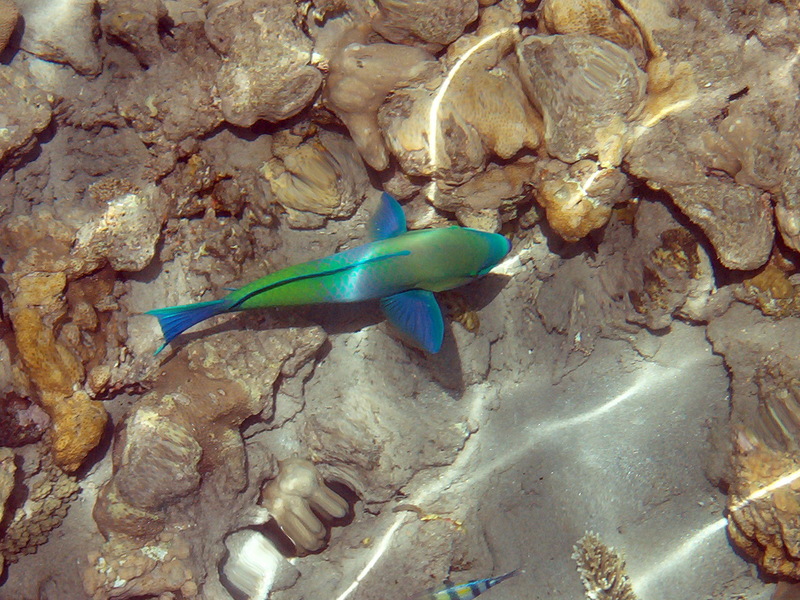Parrotfish (Family: Scaridae) - wiki Parrotfish
From Wikipedia, the free encyclopedia
[Photo] A colourful parrotfish, Eilat. Date: 19 May 2003. By http://en.wikipedia.org/wiki/User:Sputnikcccp
Parrot fish are mostly tropical, perciform marine fish of the family Scaridae. Abundant on shallow reefs of the Red Sea, Atlantic, Indian and Pacific Oceans, the parrotfish family contains ten genera and about 90 species.
Parrotfishes are named for their oral dentition; their numerous teeth are arranged in a tightly packed mosaic on the external surface of the jaw bones, forming a parrot-like beak which is used to rasp algae from coral and other rocky substrates. Many species are also brightly coloured in shades of blue, green, red and yellow, but are not especially popular in aquaria. Although they are considered to be herbivores, parrotfish eat a wide variety of organisms that live on coral reefs. Some species, for example Bolbometopon muricatum may include corals (polyps) in their diet. Their feeding activity is important for the production and distribution of coral sands in the reef biome and can prevent algae from choking coral. The teeth grow continuously, making it hard to curb overgrowth in the aquarium. Ingested during feeding, coral rock is ground up by the pharyngeal teeth.
Maximum sizes vary widely within the family, from 20 cm (TL) in the smallest species, such as the green parrotfish (Leptoscarus viagiensis) to 1.5 m (TL) in the largest species, the bumphead parrotfish ( Bolbometopon muricatum). A commercial fishery exists for some of the larger tropical species. Their meat is rarely consumed in the US; however, it is considered a delicacy in many other parts of the world. Their bodies are deep, with large, thick cycloid scales, large pectoral fins and homocercal tail fins. The pectorals are the parrotfish's primary means of locomotion, the tail only used when speed is required. Some parrotfish females can turn into male parrotfish.
Parrotfishes are diurnal and stay within shallow waters of no more than about 70 meters in depth. By night they cram themselves into crevices, some species secreting a thick coat of mucus as a sort of sleeping bag. The mucus is thought to mask their scent from nocturnal predators and may serve to protect the fish from infection by parasites.
It should also be noted that after a massive die-out of the sea urchins in the Caribbeans, parrotfish now are the main grazers in the area, the most common of which are Sparisoma viride and Scarus iseri. (Mumby and Wabnitz 2001)
The development of parrotfishes is complex and accompanied by a series of changes in coloration termed polychromatism. For most species, adult males and females have different colours, the females usually displaying drab tones of green, brown or grey, and the males vivid, conspicuous colours. In the mediterranean parrotfish (Sparisoma cretense), it is the females that have vivid coloration with the males being drab grey. In most species, the juveniles have a different colour pattern than the adults and some tropical species this juvenile coloration can be altered temporarily to mimic the appearance of other species. As the juveniles mature they enter what is termed the initial phase coloration during which they may change colour and sex. For most species, initial phase fishes are usually males that have the beginnings of the adult male coloration. However, initial phase fishes may include sexually mature females. The high variability in coloration of parrotfish has led to the different phases of many species being erroneously classified as different species in the past. Coloration is highly variable even among members of the same species. This "identity crisis" is shared by their close relatives, the wrasses of the family Labridae.
Grazing parrotfish of most tropical species form large schools grouped by size. Harems of several females presided over by a single male are the norm in other species, the males vigorously defending their status at any challenge. Curiously, if the dominant male of a harem is removed, one of the females will change sex and adopt the terminal male coloration. Parrotfish are pelagic spawners; that is, they release many tiny buoyant eggs into the water which become part of the plankton. The eggs float freely, settling into the substrate until hatching.
http://en.wikipedia.org/wiki/Parrotfish
| The text in this page is based on the copyrighted Wikipedia article shown in above URL. It is used under the GNU Free Documentation License. You may redistribute it, verbatim or modified, providing that you comply with the terms of the GFDL. |
